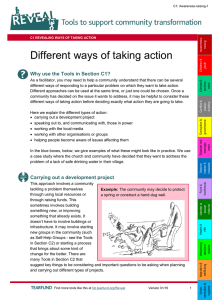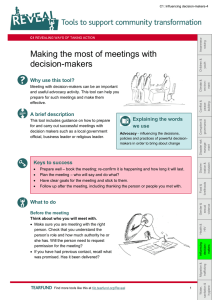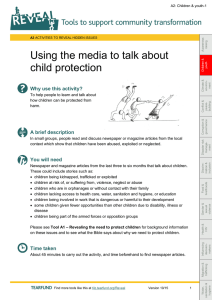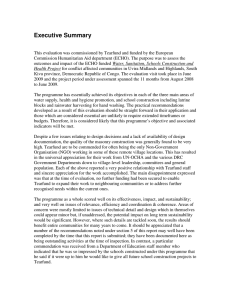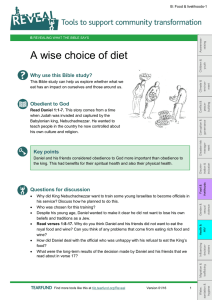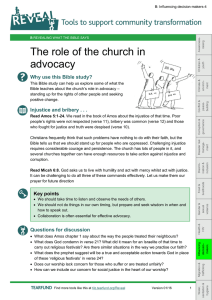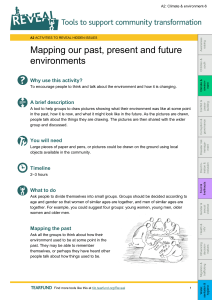Explaining the words we use – Media
advertisement
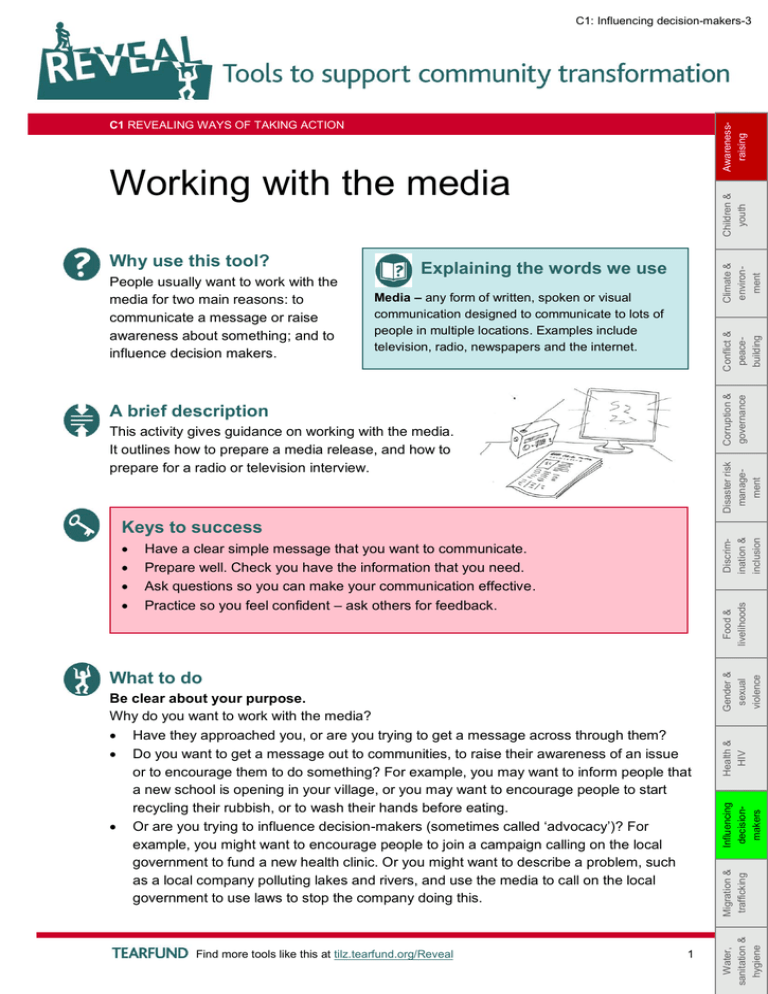
C1: Influencing decision-makers-3 Awarenessraising C1 REVEALING WAYS OF TAKING ACTION Climate & environment Explaining the words we use Media – any form of written, spoken or visual communication designed to communicate to lots of people in multiple locations. Examples include television, radio, newspapers and the internet. Conflict & peacebuilding People usually want to work with the media for two main reasons: to communicate a message or raise awareness about something; and to influence decision makers. Corruption & governance Why use this tool? Children & youth Working with the media A brief description Disaster risk management This activity gives guidance on working with the media. It outlines how to prepare a media release, and how to prepare for a radio or television interview. Find more tools like this at tilz.tearfund.org/Reveal 1 Health & HIV Influencing decisionmakers Be clear about your purpose. Why do you want to work with the media? Have they approached you, or are you trying to get a message across through them? Do you want to get a message out to communities, to raise their awareness of an issue or to encourage them to do something? For example, you may want to inform people that a new school is opening in your village, or you may want to encourage people to start recycling their rubbish, or to wash their hands before eating. Or are you trying to influence decision-makers (sometimes called ‘advocacy’)? For example, you might want to encourage people to join a campaign calling on the local government to fund a new health clinic. Or you might want to describe a problem, such as a local company polluting lakes and rivers, and use the media to call on the local government to use laws to stop the company doing this. Migration & trafficking What to do Gender & sexual violence Food & livelihoods Have a clear simple message that you want to communicate. Prepare well. Check you have the information that you need. Ask questions so you can make your communication effective. Practice so you feel confident – ask others for feedback. Water, sanitation & hygiene Discrimination & inclusion Keys to success C1: Influencing decision-makers-3 C1 WORKING WITH THE MEDIA Awarenessraising Develop a clear message Be very clear about what you want to communicate and keep it simple. Consider the best way of communicating your story for the chosen media. You could choose story telling if you are communicating through television or radio. You may choose facts and images for newspapers or the internet. Children & youth Climate & environment Conflict & peacebuilding Select the appropriate type of media you want to work with If you are hoping to communicate with families, should you work with television programme producers? If you want to communicate with employed adults, or people who have time to read whilst travelling to work, you may want to work with newspaper editors. If you are communicating with young people who have access to computers you may want to use social media such as Facebook. Or you could use social media such as internet blogs (web-pages telling stories) or Twitter to communicate with politicians, academics or international audiences. Corruption & governance Written media messages Disaster risk management Discrimination & inclusion Food & livelihoods A media release is a written document that is sent to different media contacts to try to get messages on to the radio or television or in printed media such as newspapers or onto digital media such as news agency websites. Media releases are written in different styles but often contain the following information: What is happening / has happened? This is called “THE MEDIA STORY” Who, where and when? “THE FACTS” Why it is happening / has it happened? “THE ANALYSIS” How is it affecting people and why is this important? “THE RELEVANCE” What needs to happen now? “THE REQUEST TO DECISION-MAKERS OR THE AWARENESS-RAISING MESSAGE” Gender & sexual violence Health & HIV Influencing decisionmakers Migration & trafficking Writing a media release: what to do Include the basic information in the first paragraphs (what, who, where and when). Most people only read the first few lines of a written article. Include a direct quote from a spokesperson and an example or story, to make your point. Explain why the issue you are writing about is interesting or relevant to the general public. Why would people want to read what it says? Include good quality photographs, if possible, as this can greatly improve the chance of your story being included in a newspaper or on a website. Ensure that facts are correct and put contact details and any further information at the bottom of the media release, as well as any additional information and statistics. Once the media release has been sent, contact the person who has received it, in order to find out whether they will cover the story or want more information. Water, sanitation & hygiene Find more tools like this at tilz.tearfund.org/Reveal 2 C1: Influencing decision-makers-3 C1 WORKING WITH THE MEDIA Find more tools like this at tilz.tearfund.org/Reveal Children & youth Climate & environment Conflict & peacebuilding Corruption & governance Disaster risk management Health & HIV Related tools B – Advocacy work (Bible study) [B: Influencing decision-makers-1] B – Being an advocate (Bible study) [B: Influencing decision-makers-2] C1 – Ways of taking action [C1: Awareness-raising-1] C1 – Advocacy – communicating with people in power [C1: Influencing decision-makers-1] C1 – Mobilising people [C1: Influencing decision-makers-2] C1 – Making the most of meetings with decision-makers [C1: Influencing decision-makers-4] Influencing decisionmakers Migration & trafficking Tearfund (2014) Advocacy toolkit http://tilz.tearfund.org/en/resources/publications/roots/advocacy_toolkit/ Tearfund (2006) A PILLARS Guide: Seeking justice for all: http://tilz.tearfund.org/en/resources/publications/pillars/seeking_justice_for_all/ Tearfund’s TILZ pages on advocacy: http://tilz.tearfund.org/en/themes/advocacy/ 3 Water, sanitation & hygiene Gender & sexual violence Finding out more Discrimination & inclusion Preparing for an interview: what to do Be as well prepared as possible. Find out as much about the programme or publication as you can beforehand. You could ask the journalist: o how they intend to present the issue (ie what angle they intend to take) and why they have chosen this particular topic o what the target audience for the publication or programme is, if you don’t know already o whether it will be live or recorded and whether you will be the only person interviewed or whether it will be a debate Do not be worried about stating the limitations on what you are prepared and/or able to talk about. If you can only talk about a particularly area or topic, be clear about this with the journalist, so that you do not get drawn into wider discussion beyond your experience. Think of difficult questions you might be asked beforehand – and practice your answers. Check the latest information and have the necessary facts written down in front of you to back up your arguments. Be clear about your core message or messages. Write down the three main points you want to make and stick to them. Use stories and examples to make your points clearer. Don’t ignore questions, but steer your answers towards what you want to say. You could use the ‘ABC rule’: - Acknowledge the question (‘Yes, that’s an important point…’) - Bridging phrase (‘But really the fundamental problem is…’) - Communication (‘The real point is…’) Be confident in your knowledge and experience. Remember that you are likely to know more about the issue than the interviewer. Food & livelihoods Sometimes, we have opportunities to share media messages verbally, through radio, television, internet or other media. Awarenessraising Spoken or visual media messages
